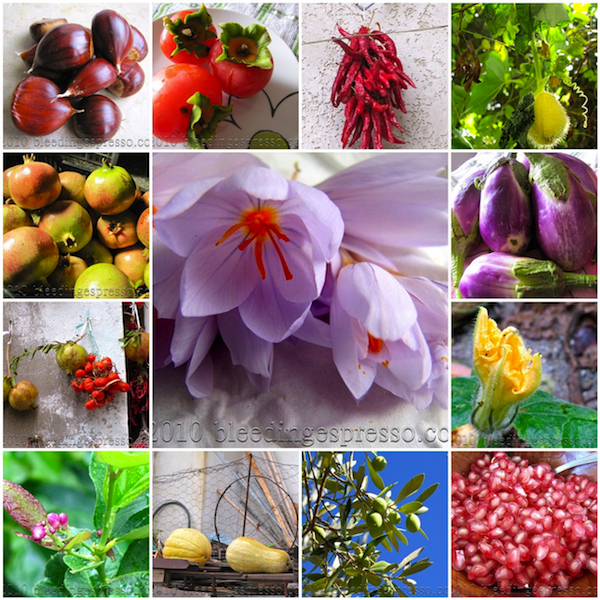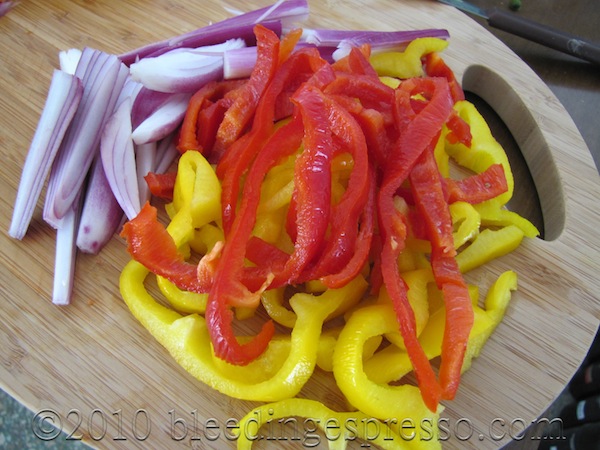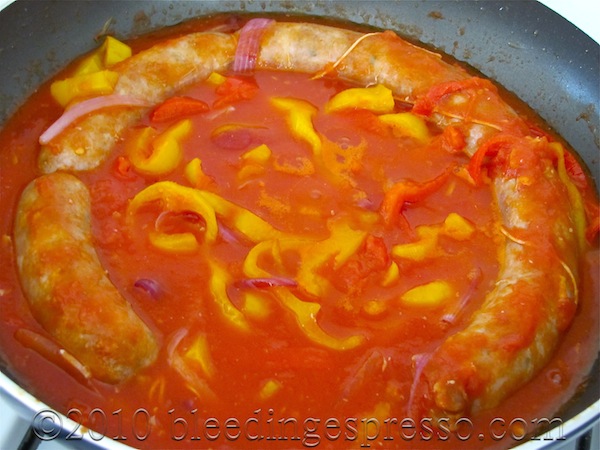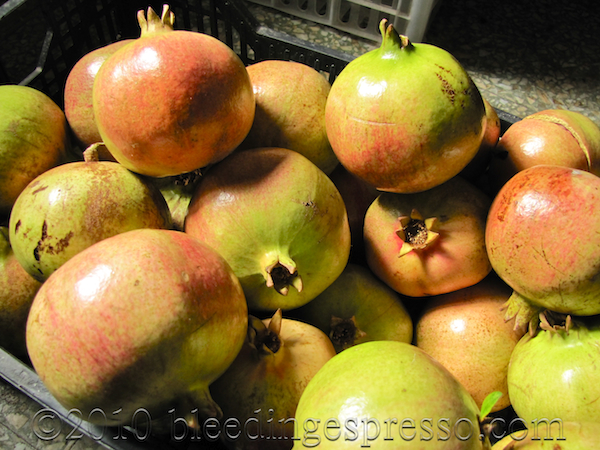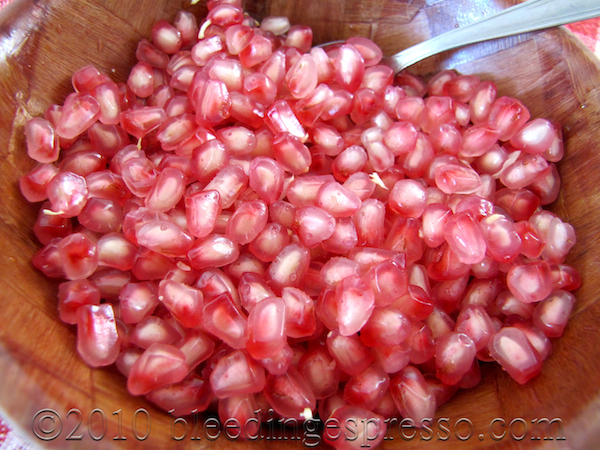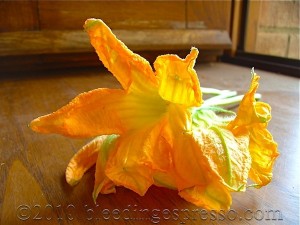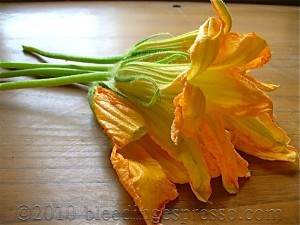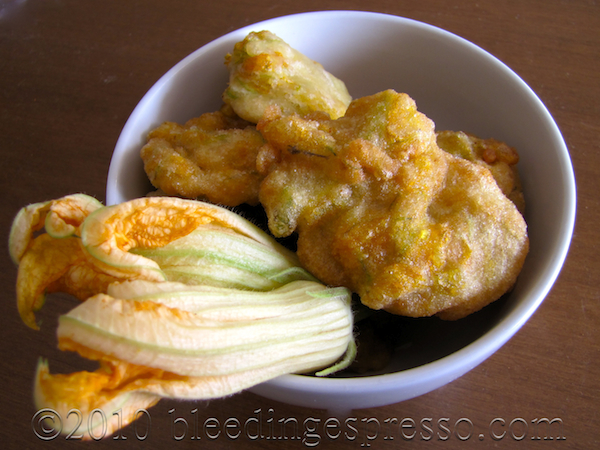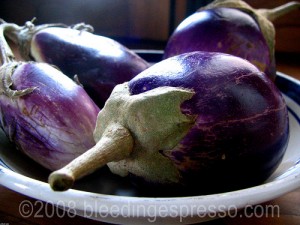Archive for the ‘food’ Category
The Colors of Fall in Calabria
We do get some leaves changing color here, but fall in Calabria actually is quite colorful besides those warm autumnal hues I grew up with in the mountains of Pennsylvania:
1. Saffron flowers, 2. Chestnuts, 3. Persimmons, 4. Drying peperoncini, 5. Prickly zucchine, 6. Melagrane dal giardino, 7. Eggplant, 8. Hanging out, 9. Zucchine flower, 10. Lemon blossom after the rain, 11. Zucche, 12. Some of our olives in September, 13. Pomegranate seeds
Many of us expats in Italy have written about being more in touch with the seasons here than we were in our home countries, mostly because our routines are so much more ruled by what the weather is like outside. Over the past month or so, for instance, many of us have been busy gathering wood, picking olives, preserving the summer’s bounty for enjoyment all winter, and thinking about all the soups, stews, and dishes “al forno” we’ll be making for the next few months. The first “signs o’ fall” if you will.
And yes, for me, there have been other changes in the routine, like feeding the goats and locking the hens in the henhouse just a little bit earlier in the evenings and also picking back up some habits that had fallen by the wayside over a busy summer — wonderful daily commitments like yoga and working on a dusty old manuscript, and also weekend projects like finding little ways to make the house that much cozier.
We’ll be spending quite a bit of time in here in the coming months, after all.
Yes, fall here always inspires me to dig back into the good, warm, comfortable, and cozy . . . which comes first, the cooler weather or the nesting mentality? I don’t know, but I’m not complaining.
What says “fall” to you?
What’s Cooking Wednesday: Sausage and Peppers
To be perfectly honest, I didn’t love sausage when I lived in the States; here in Calabria is a whole other story, though, and one of my favorite ways to prepare salsiccia is with peppers and onions in tomato sauce.
P had never had sausage prepared this way before I came along, but it’s been one of my family’s favorites from back when my grandmother made it — and it has quickly become one of P’s favorites as well.
And you want to talk about easy? There are only five steps!
A couple notes before we dig in:
I prefer using sweet sausage, red onion, and red and yellow peppers:
You are, of course, welcome to play with various combinations that may include spicy sausage and green peppers. Here our sweet (“dolce”) sausage tends to have a little kick with peperoncino, so don’t be afraid to add a little hot pepper even if you’re using sweet sausage; mostly it will just heighten flavors if you don’t use too much.
Also, I like to make extra sausage and sauce so we can have it with pasta the next day — the first day we usually do the sausage and peppers on hard rolls (sausage and pepper hoagies for those of you who know what a hoagie is). This is why I use two cans of tomato sauce; if you only want to use this for one meal, one can is probably plenty. This is definitely one of those sauces, though, that tastes even better the next day, so I highly encourage making enough for leftovers.
Sausage and Peppers
- Sausage links
- 1 tablespoon olive oil
- 2 large or 3 medium peppers, julienned
- 1 large onion, julienned
- 1 large clove of garlic cut in half
- 2 cans of tomatoes/tomato sauce
- Salt to taste
1. In a large nonstick pan on medium to high heat, brown sausage (about 10-15 minutes).
2. Remove sausage from pan and set aside. Turn down the heat a bit and add the olive oil, peppers, onion, and garlic. Saute until peppers and onions soften, at least five minutes.
3. Return sausage to pan and add tomato sauce, using about a quarter cup of water to rinse out the can (add that water to the pan as well). Add salt as desired.
4. Cover and let simmer, stirring occasionally, until tomato sauce tastes ready to you. This will take at least 15-20 minutes, but could take longer depending on your tastes. If you like a thicker sauce, be sure to take the lid off the pan at some point, which I do after about 15 minutes.
5. Serve sausage on hard rolls with plenty of sauce, peppers, and onions *or* serve with pasta (we prefer penne with this).
Buon appetito!
A Surprise Crop of Pomegranates
On the border of our garden (which wasn’t a garden this year because we were too busy with the new campagna to plant anything), is a line of pomegranate trees. The land is terraced, so they’re not very easy to see down there on the slope, and to be honest, since they produced a grand total of two pomegranates last year, I wasn’t really paying attention to them.
Well P and I caught a glimpse of them early this morning, and they were absolutely *full* of melagrane!
I love pomegranates, or as we called them back in the Pennsylvania Coal Region, “Indian apples.” I actually didn’t know the fruits were one and the same until I learned about mythology and the story of Persephone in Hades. See, public school education works!
I’ve written about pomegranates before as the harbingers of the fall here in southern Italy — and indeed, the past few days have had a distinct autumnal chill in the air overnight . . . which means my loverly October is just around the corner. Yay!
Now if you’ll excuse me, I have a bowl of seeds to chomp on to keep my antioxidants up.
How do you enjoy pomegranates?
Zucchini Flower Fritters – Frittelle di Fiori di Zucca
Longtime readers might remember my zucchini flowers stuffed with ricotta, spinach, and prosciutto crudo as well as fried zucchini flowers.
Well this time when I picked up some zucchini flowers at the market, P asked if I would make some fritters, which is the usual way they’re made in this area of Calabria.
P’s aunt has made them for us many times, but I had never asked for the recipe or technique. As luck would have it, the day I bought the flowers, she happened to be walking by the house when I took the dogs out for their lunchtime walk.
The recipe she gave me on the spot is below; of course there are no measurements, but I have faith in you!
Seriously if you’re afraid of working with zucchini flowers, it’s time to conquer the fear. I was right there with you, but these fritters are amazingly simple and delicious. Enjoy!
Zucchini Flower Fritters – Frittelle di Fiori di Zucca
- Bunch of zucchini flowers
- Flour
- Water
- Pinch of baking soda
- A few pinches of salt
- Oil for frying
1. Clean the zucchini flowers by snapping out the stamens (assuming you have male flowers, the ones attached to stems).
2. Chop roughly into pieces and place in boiling water for about a minute.
3. Remove with a slotted spoon and set aside.
4. Mix together flour, water, some salt, and a pinch of baking soda so that you get the consistency of pancake batter. Fold in the flowers. This part, by the way, is completely up to your tastes. When P’s aunt makes them, to be honest, I don’t taste much of the flowers because there’s so much, well, flour. I like mine bursting with zucchini flower flavor — they also look prettier, I think, as the flower colors show through. So use your own taste to determine how much batter to flowers you should make.
5. Heat oil for frying (I use last year’s olive oil) in a shallow pot or pan. You’ll want enough in there so the batter can sink to the bottom and then have a little way to rise and dance at the top, and you also don’t want your fritters crowded. The pan I used fit three fritters at a time. Zia also told me to throw in a pinch of salt when ready to fry.
6. When the oil is hot, take a large spoonful of batter and drop it in. As mentioned above, it will sink at first but then rise as it fries. Turn them a bit until you see all sides are browned, remove with a slotted spoon, and place on paper towels to drain.
Buon appetito!
Should You Take an Italian Cooking Class?
Today we’re welcoming Brian Jenkins with a guest post about a subject I know many of you are interested in — Italian cooking. Of course you can always check out my recipes, but if you’ve always wanted to perfect your Italian culinary skills but don’t have a nonna to turn to, this post is for you.
*
Should You Take an Italian Cooking Class?
Are you wondering how to prepare authentic, tasty Italian dishes? Do you have a desire to do more when you make Italian food? Perhaps you have spent a long time yearning to make delicious Rollatini di Pollo served with a properly chilled bottle of Chardonnay.
There are plenty of restaurants and culinary schools offering Italian cooking courses. And no, you don’t have to be a little bit Italian to take the courses! You can have fun, improve your Italian cooking skills and enjoy some scrumptious food. Buon appetito!
Impress friends and family members by making a delicious Italian meal. No longer will your guests’ “that was delicious pasta” comment be dripping with insincerity! Well, let’s hope not.
A Google search such as “cooking courses Boston” (replace Boston with your city of residence) may just provide a few nearby restaurants that offer Italian one-day or longer cooking classes. Some of the classes teach students to make a five-course meal. Typically, students are part of a cooking team. Classes usually take two to three hours after which it’s time to enjoy a tasty Italian meal.
- The Italian Culinary Academy, located in New York City, offers amateur and professional programs through a variety of part-time amateur night classes. The courses include two or three sessions. Attend a high quality Italian culinary school during a New York City vacation. Sell your collection of antique ascots and dine at Babbo Ristorante.
- Cooking Vacations offers hands-on cooking classes and cultural tours in Italy’s 20 regions. Students are taught to prepare traditional Italian recipes by skilled chefs, local expert cooks, bread and pizza makers and Nonnas. The culinary holiday includes visits to markets and tours of vineyards and cultural landmarks.
- The International Kitchen offers a variety of Italian cooking vacations. The programs combine sightseeing and cooking classes taught by expert chefs. How about making scrumptious dishes from Umbrian recipes? Your friends will be inquisitive and hopefully impressed.
If you are one of those people who have a casual interest in cooking, taking a cooking class at a local restaurant may well be the best option. Here are some restaurants that offer cooking classes for a small sampling of cities across the US:
- Taranta (Boston, MA)
- Chef Andy (Orlando, FL)
- A Tavola (Chicago, IL)
- A Taste of Italy in Austin (Austin, TX)
- Andy Food (Scottsdale, AZ)
- Tante Marie’s Cooking School (San Francisco, CA)
- Rustico Cooking (New York City, NY)
Invest a little time and reap the rewards for the rest of your culinary life!
*
Brian Jenkins writes on Cooking Schools and other topics for Braintrack.com.
*
Have you ever taken a cooking class? Would you recommend it to others?

